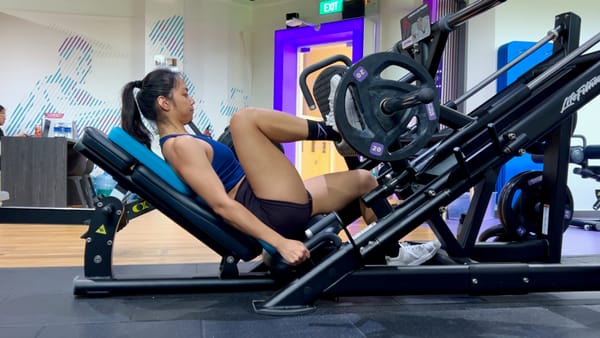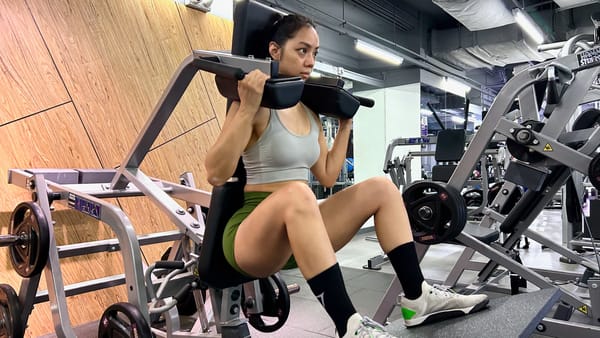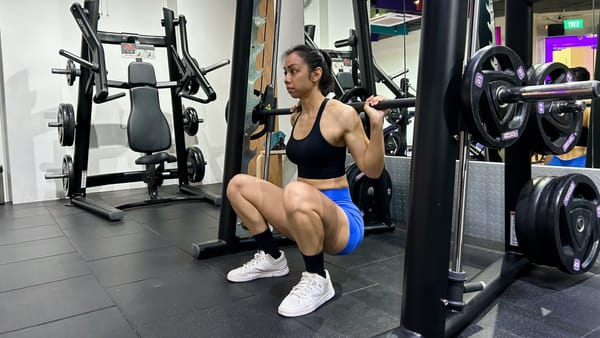The 7 Best Dumbbell Shoulder Exercises for Capped Delts
Want capped delts? Here are the best dumbbell shoulder exercises you can add to your workouts. Practical, time-tested, and easy to progress on.
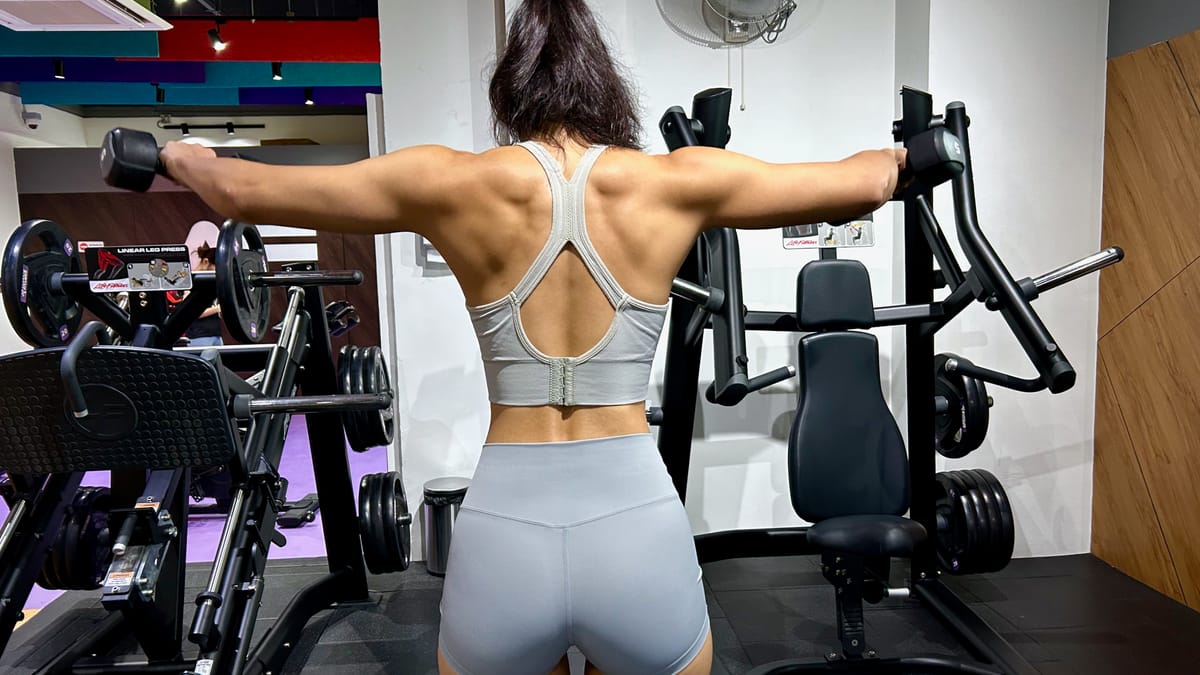
Working towards your capped delts? It doesn’t have to be just lateral raises and shoulder presses. 🥱
We know you’re sick of spamming the same old exercises. They’re great, but there are other options too!
That’s why we’re going to explore the best dumbbell shoulder exercises out there. So you know your options and can shake things up for a change.
What makes a good dumbbell shoulder exercise?
You’re a savvy reader. That’s why this can’t be yet another crudely compiled list of exercises that isn’t all that helpful.
So, let’s set some standards.
Criteria for the best dumbbell shoulder exercises:
- Simple, straightforward movement pattern
- Easy to make progress on
- No combination exercises
This means you won’t see exercises such as the Arnold press or bicep curl to shoulder press.
It’s fine to train with them, but for hypertrophy, they’re definitely not our top picks for hypertrophy
🤔 Our training rule is to keep it simple. (OK, we just made this up, but it’s a good point!)
Overview of the best dumbbell shoulder exercises
Your shoulders should be trained in a comprehensive way.
Make sure you target all 3 parts of your shoulders: front delts, mid delts, and rear delts.
Here, we’ve grouped the exercises based on which part of your delts they target.
| Exercise | Main target muscle | Variation |
|---|---|---|
| Dumbbell shoulder press | Front delts | Standing dumbbell shoulder press |
| Dumbbell front raise | Front delts | Seated dumbbell front raise |
| Dumbbell lateral raise | Mid delts | Chest-supported dumbbell lateral raise |
| Dumbbell upright row | Mid delts | Seated dumbbell upright row |
| Dumbbell reverse fly | Rear delts | Chest-supported dumbbell reverse fly |
| Dumbbell incline Y raise | Rear delts | - |
| Dumbbell rear delt row | Rear delts | Chest-supported dumbbell rear delt row |
#1 Dumbbell shoulder press
Main target muscle: Front delts
Demo of the seated dumbbell shoulder press:
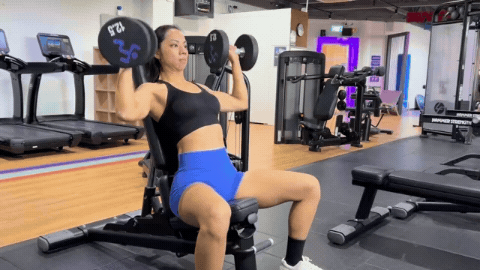
Quite possibly the first shoulder exercise you were taught.
The dumbbell shoulder press is a staple for anyone training to get capped delts.
It targets your front delts very well, followed by the mid delts.
Unimportant but fun detail: you can go much heavier on the shoulder press than on other dumbbell shoulder exercises.
Once you've worked your way up in weight, you might run into some trouble with setup.
2 typical problems:
- Dumbbells are too heavy to “kick up”
- Can’t get dumbbells off your shoulders and to your “starting height”
This is when you should ideally work with a spotter.
Common mistakes:
- Letting your elbows move behind your wrists
- Bending your wrists back excessively
- Not stabilizing your core and lower body
- Using weights you can't safely work with
Tips:
- Keep your elbows and wrists stacked vertically
- Use a neutral wrist position and grip firmly
- Brace your core for a stable setup
- Drive your legs onto the floor to prevent swaying
- Use a spotter for heavier weights
- Plant your back firmly against the bench
Should you only shoulder press in the scapular plane? Not necessarily. There isn’t any strong evidence to suggest that a specific path is the best.
For most, the scapular plane (30 to 45 degrees horizontal arm angle) is simply a good starting point for ROM and comfort. That’s why you’ll hear everyone preaching about it.
You should experiment to see which arm path you feel most comfortable with and the strongest in.
Dumbbell shoulder press variation
Don’t have access to a bench? You can do this standing version, too.
Standing dumbbell shoulder press:
#2 Dumbbell front raise
Main target muscle: Front delts
Demo of the dumbbell front raise:
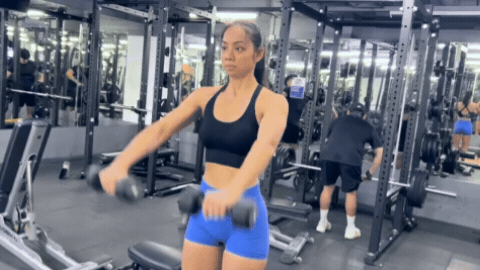
Warning on the dumbbell front raise: you’re going to get this sacred advice eventually.
“You work your front delts enough if you do plenty of chest exercises, so this isn't necessary at all.”
And unlike some of the iffy advice you get in the gym, this is a fact!
Any pressing movement is going to involve your front delts.
So, if you’ve already included a good amount of chest exercises in your program, you probably don’t need to add a front raise to your shoulder training.
Look at your program and decide if front raises deserve a spot.
Common mistakes:
- Leaning back excessively to get the weight up
- Using too much weight
- Not controlling the weight down
- Extending your elbows fully
Tips:
- Brace your core and squeeze your glutes
- Avoid using momentum to bring the weight up
- Control the weight on its way down
- Work with a weight you can do for at least 10 reps
- Maintain a slight bend in your elbows
Wondering why the front raise is often singled out (but not the shoulder press)? This is likely because front raises are, in comparison, more limited in what they train.
They’re super focused on front delts and not much else. Shoulder presses offer more bang for your buck.
Dumbbell front raise variation
Try doing this exercise in a seated position to reduce momentum.
Seated dumbbell front raise:
#3 Dumbbell lateral raise
Main target muscle: Mid delts
Demo of the dumbbell lateral raise:
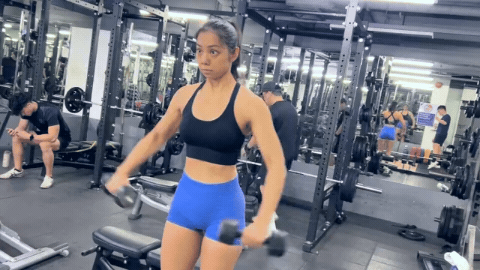
The dumbbell lateral raise is another staple shoulder exercise for anyone trying to build capped delts!
It’s one of the best dumbbell shoulder exercises for a good reason: it targets the mid delts really well.
Since the mid delts are the biggest of the 3 shoulder muscle parts, it’s often recommended that you focus on them (more than the other 2) to maximize your results.
Besides, we all want to add width and shape to our shoulders.
And the part of your shoulders responsible for that look? You guessed it: the mid delts.
Common mistakes:
- Swinging the weight up excessively
- Using too much weight
- Not controlling the weight down
- Extending your elbows fully
Tips:
- Lean forward slightly and brace your core
- Avoid using momentum to bring the weight up
- Control the weight on its way down
- Work with a weight you can do for at least 10 reps
- Maintain a slight bend in your elbows for better results
With dumbbell lateral raises, don’t get overly ambitious with the weight. It’s simply not an exercise you can go very heavy on.
Instead, focus on maintaining good form and progressing in reps before you increase the weight.
Dumbbell lateral raise variation
Try doing the lateral raise with a bench for a more stable setup that eliminates momentum and lets you focus better on the movement.
Chest-supported dumbbell lateral raise:
#4 Dumbbell upright row
Main target muscle: Mid delts
Demo of the dumbbell upright row:
Ah … the controversial shoulder exercise no one's willing to talk about.
TLDR: the upright row got a bad rep because it supposedly causes shoulder injuries from all that internal rotation under load.
Is that true? Well, there’s no published evidence suggesting that doing the upright row is more likely to cause injuries.
In our opinion, it’s still a wonderful exercise. Just be smart about it.
Don’t get impatient and start working with weights you’re not ready for. Stick with good form and progress gradually.
If you do it with good form and it still causes discomfort, just skip the exercise! Don’t overthink it.
Warning: you can use quite a lot of weight on the dumbbell upright row, so don’t get carried away.
Common mistakes:
- Letting the weight move too far forward
- Using momentum to swing the weight up
- Limiting your ROM
- Keeping the dumbbells too close together
Tips:
- Keep the dumbbells as close to you as possible
- Avoid swinging the weight up
- Start with the dumbbells at least shoulder-width apart
- Let the dumbbells move apart as you row upwards
- Lean forward slightly for a more comfortable dumbbell path
Are dumbbell upright rows better than barbell upright rows? This comes down mostly to comfort. You’d need to try it out for yourself.
Many people prefer the dumbbell upright row for its more comfortable wrist position. Of course, you won’t be able to go quite as heavy as with the barbell version.
Dumbbell upright row variation
You can avoid using momentum by sitting down instead of standing.
Seated dumbbell upright row:
#5 Dumbbell reverse fly
Main target muscle: Rear delts
Demo of the dumbbell reverse fly:
The dumbbell reverse fly is one of the best dumbbell shoulder exercises for your rear delts.
You’d often hear that you’re likely neglecting your rear delts. And this might be true.
Unlike the front delts, which are inevitably trained with chest exercises, the rear delts don’t have the same luxury.
Here’s the thing: back exercises (or really anything with a rowing movement) will target your rear delts to some extent.
But you likely wouldn’t be training your rear delts enough if you don’t use larger arm angles or if you don’t train your back much.
And that’s why having dedicated exercises to train your rear delts is such a common recommendation.
Common mistakes:
- Swinging the weight up excessively
- Using too much weight
- Not controlling the weight down
- Extending your elbows fully
Tips:
- Brace your core
- Keep the same angle of lean throughout
- Don't use momentum to bring the weight up
- Control the weight on its way down
- Use a weight you can do for at least 10 reps
- Maintain a slight bend in your elbows
Dumbbell reverse fly variation
To get more support for this exercise, try using a bench.
Chest-supported dumbbell reverse fly:
#6 Dumbbell incline Y raise
Main target muscle: Rear delts
Demo of the dumbbell incline Y raise:
You might not see this often in the gym, but this is a solid dumbbell exercise!
The dumbbell incline Y raise targets the rear delts and strengthens the lower traps to improve the stability of your scapular.
Whether your goal is hypertrophy or strength, this exercise has something to offer.
Common mistakes:
- Keeping your elbows straight
- Not using the full ROM
- Dropping the weight too quickly
Tips:
- Maintain a slight bend in your elbows
- Raise the weight until your arms form a straight line with your torso
- Control the weight on the way down
- Plant your torso firmly on the bench
The dumbbell incline Y raise is similar to the chest-supported dumbbell lateral raise in setup.
But instead of stopping at 90 degrees, keep going until you run out of ROM (roughly where your elbows and torso form a straight line).
Naturally, you won’t be able to use as much weight here as you do on lateral raises.
#7 Dumbbell rear delt row
Main target muscle: Rear delts
Demo of the dumbbell rear delt row:
The dumbbell rear delt row (aka dumbbell incline row) is one of the best shoulder exercises for targeting your rear delts.
It feels very similar to the bent-over row, just with a larger arm angle.
You could also think of this as a dumbbell reverse fly done with a rowing motion.
Common mistakes:
- Swinging the weight up excessively
- Keeping your elbows too close to your lats
- Not controlling the weight down
- Limiting your ROM
Tips:
- Avoid using momentum to move the weight
- Use a larger arm angle of at least 45 degrees to better target your rear delts
- Control the weight on the way down
- Row the weight until your elbows move past your torso
The larger arm angle is key here if you want to target your rear delts more effectively.
As a guide:
- Smaller arm angle = more lats
- Larger arm angle = more rear delts
Dumbbell rear delt row variation
For a more stable setup, you can try this version with a bench.
Chest-supported dumbbell rear delt row:
How do you choose the best dumbbell shoulder exercises?
Let’s narrow down your options by thinking about how and why you train.
This should give you a clearer idea of which dumbbell shoulder exercises to pick.
Target all 3 delts with your choice of exercises
You should train all 3 parts of your delts so they grow stronger and bigger together.
In practice, you could place more emphasis on training your mid delts, followed by your rear delts and lastly, your front delts.
✅ Suggested order of priority: mid delts > rear delts > front delts
Why in this order?:
- Front delts are likely sufficiently trained from pressing exercises such as bench press and incline press.
- Rear delts can be targeted with rowing exercises such as seated row (although the setups would need to be more intentional than with pressing exercises).
- Mid delts have the least overlap with other exercises in a typical training program.
Assess your program to how much pressing and rowing exercises you currently have before deciding on how many exercises you want to dedicate to each part of your delts.
Aligned with your goals and interests
Make sure your choice of exercises are aligned with your goals.
Specificity matters. Train as closely as you can to the movements your interests or goals require.
If you enjoy weightlifting (e.g., clean and jerk), you’re probably going to benefit more from dumbbell upright rows than dumbbell lateral raises.
For hypertrophy, it’s simpler. Just focus on what’s most efficient and easiest to progress on for you.
Choose exercises that you like best
We don’t think this is said enough: what you like matters A LOT! Choose exercises that make you happy.
If you enjoy the exercises you’re doing, you’re going to be more consistent at them.
That’s going to make a huge difference in the long run.
Don’t fall into the trap of simply following what’s most popular on social media. Just because it’s trendy doesn’t mean it would work for you.
Besides, exercise trends come and go. Remember when it was practically illegal to do upright rows because they were supposedly a disaster for your shoulders? 🫣
FAQs about dumbbell shoulder exercises
You (probably) have some questions, so we’re going to guess what they are and hopefully answer them here.
Are dumbbells the best option for training shoulders?
Nope, the choice of equipment depends on your training needs and preferences.
You have plenty of options for shoulder exercises: specific machines, barbells, cable, Smith machines, landmine, and more.
For building muscle, stick with the exercises you can progress the best on.
If you can, include exercises with different resistance profiles for even better results.
Why do I use so little weight on shoulder exercises?
This is something everyone wonders about when they first start hitting the gym.
You see, your shoulders are strong.
But they can never be quite as strong as bigger muscle groups such as the chest and back.
(Just look at your shoulders and get a sense of how big they actually are.)
This is why you use so little weight on shoulder exercises and can only manage relatively small jumps in weight.
For example, a 2 kg increase on the bench press doesn’t do much, but a 2 kg increase on dumbbell lateral raises? That might be enough to stop you from even starting your rep. 🫨
Should I do high reps for more toned shoulders?
Not at all. That’s based on an outdated belief that higher reps make muscles look more “toned”, while lower reps make muscles look “bulkier”.
There isn’t a superior rep count. Although it’d be smart to avoid extremes (anything less than 4 or more than 30) for hypertrophy.
In practice, 6 to 20 reps seem to be the sweet spot. This is why you’d find most programs using 8 to 12 reps by default. It’s the safe middle!
Want to get toned? There’s a right way to do it:
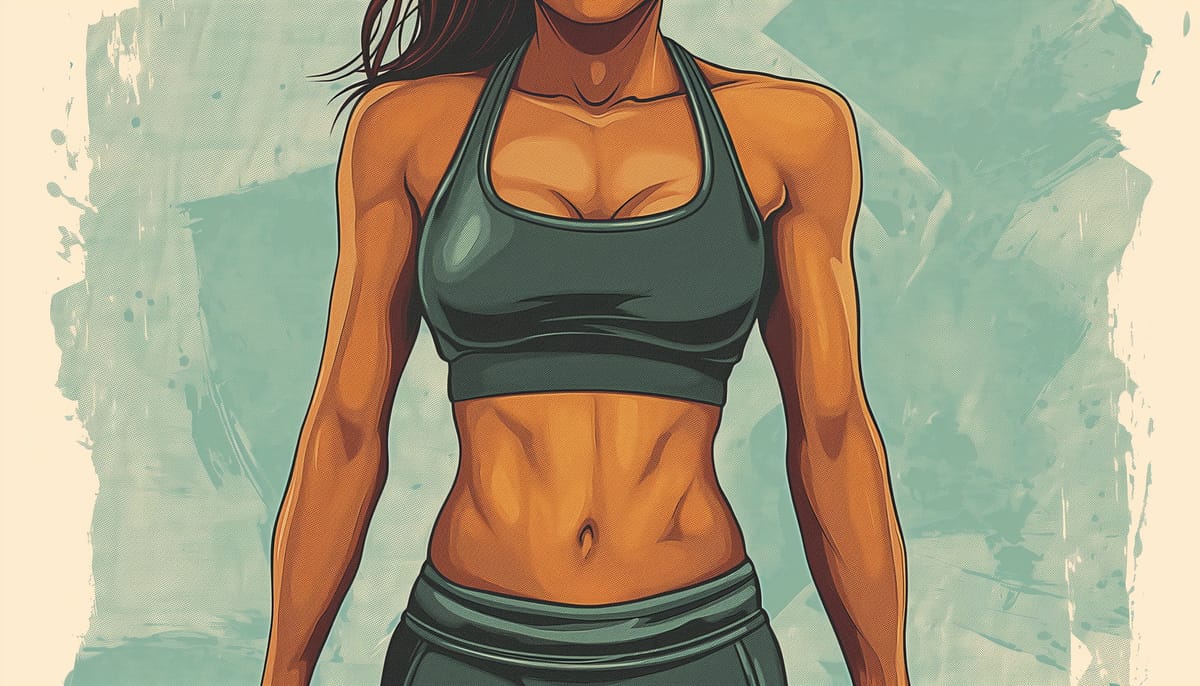
Are supported or free-standing shoulder exercises better?
This depends on your goals.
For building muscle, your choice of shoulder exercise can be more inclined to supported ones such as seated shoulder press or dumbbell incline Y raise.
A stable setup would likely help you progress more consistently and train closer to failure.
If your stabilizer muscles are lagging (or you’re into weightlifting), you could include more free-standing shoulder exercises.
In practice, we do most of our shoulder exercises with support.
We believe the benefits of a stable setup for shoulder exercises far outweigh any advantage that free-standing options have.
Besides, there are much better ways to train your stabilizers.




